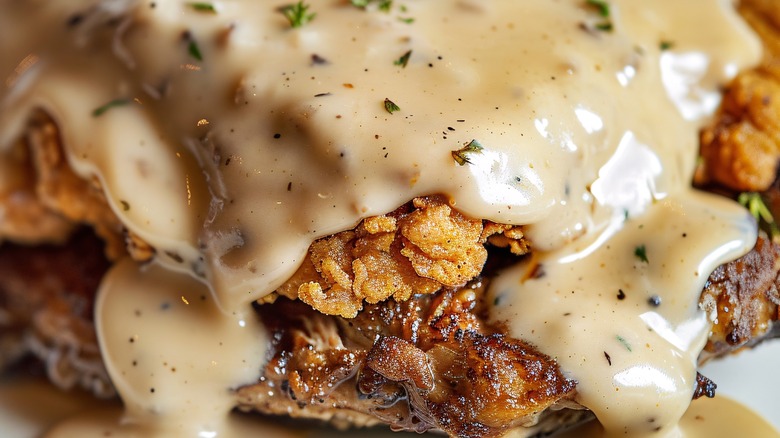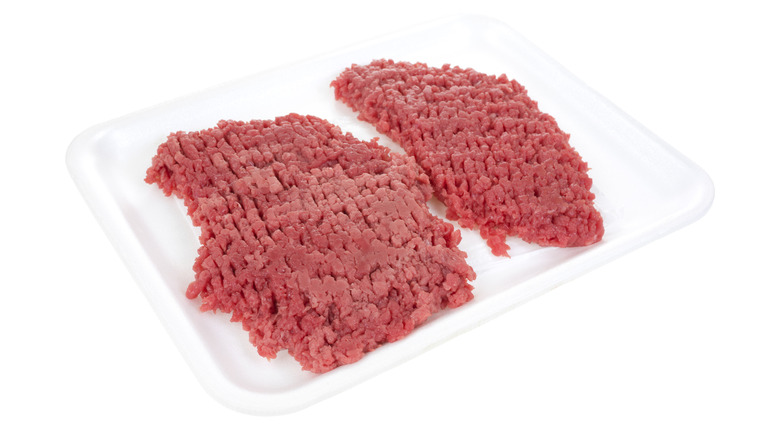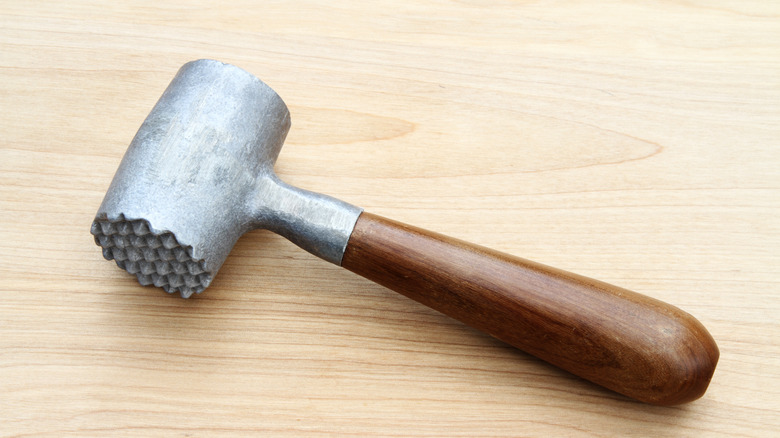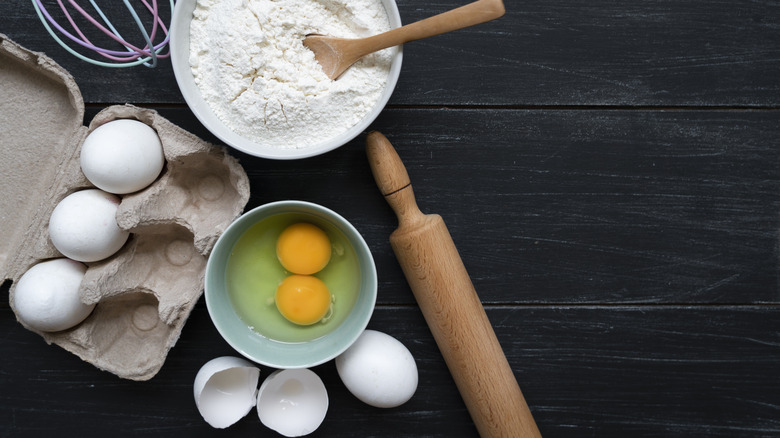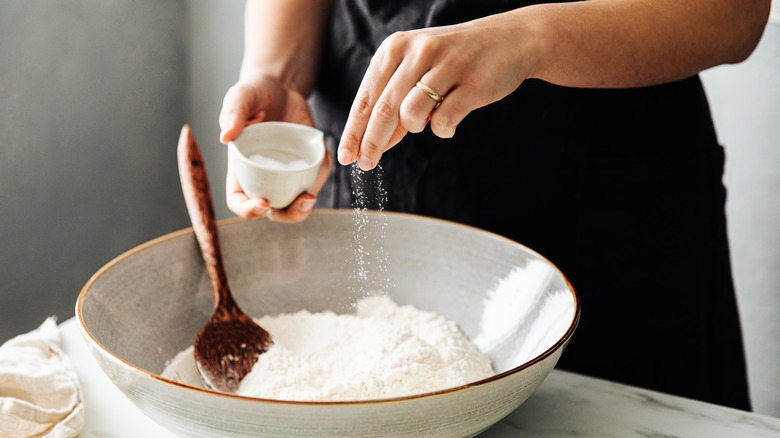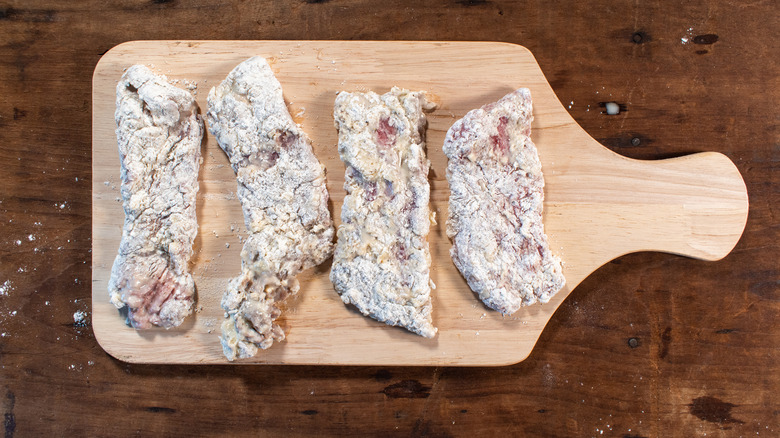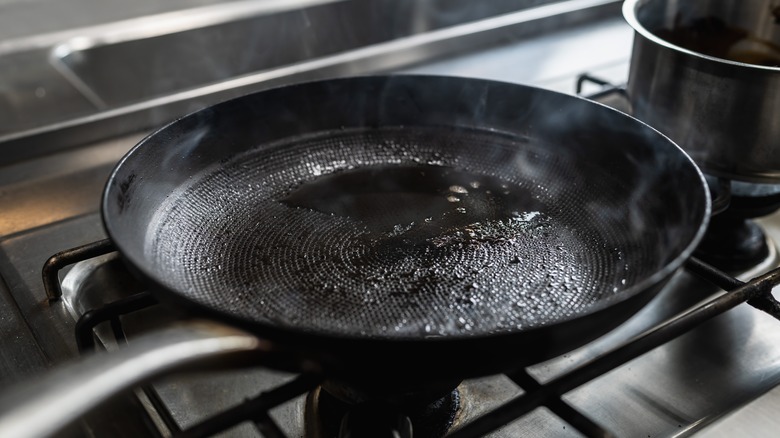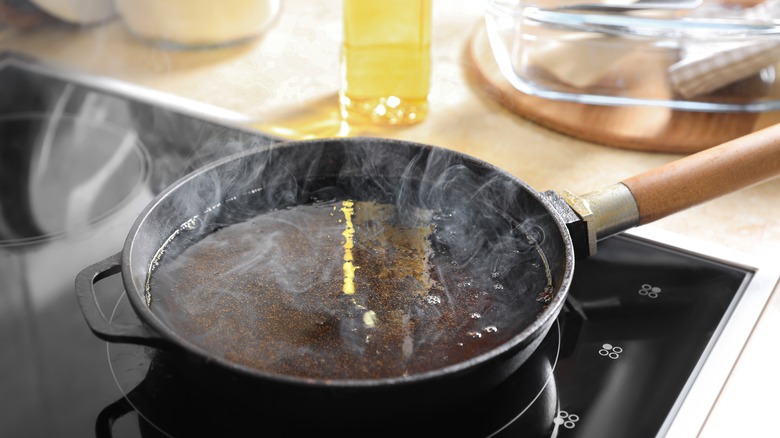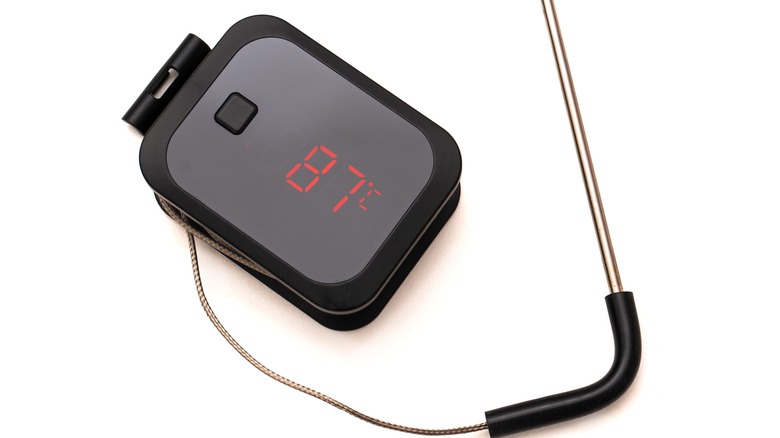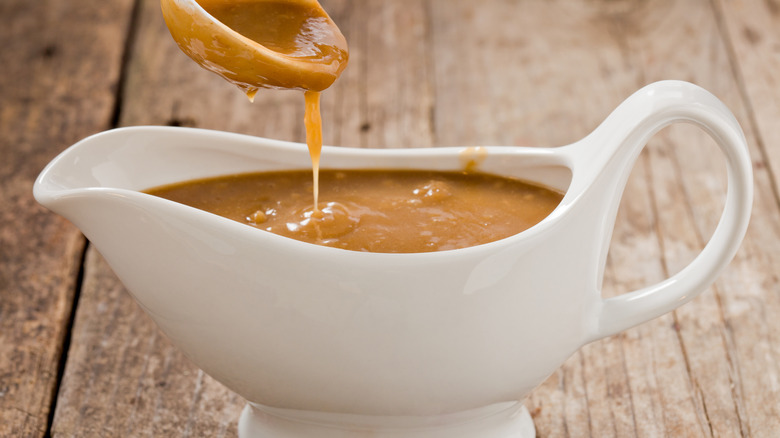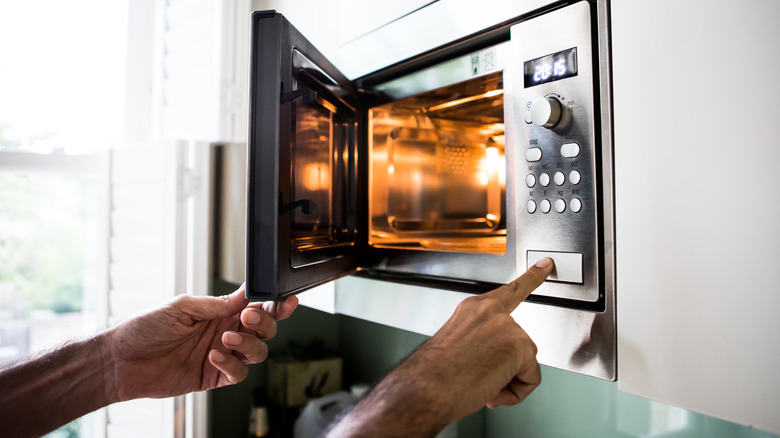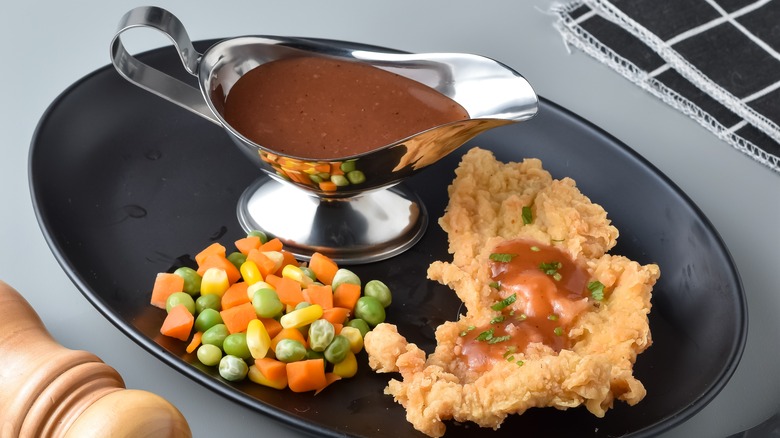Mistakes Everyone Makes When Cooking Country Fried Steak, According To Professional Chefs
Country fried steak is a comfort classic that is common in Southern cuisine. What could be better than a juicy, tender steak coated in a crispy fried crust and doused with a heaping portion of homemade gravy? You may have heard of country fried steak and chicken fried steak and thought they were the same dish. While used interchangeably in many cases, there are some notable differences between the two that connoisseurs may school you on — one being the color of the gravy.
Country fried steak has brown gravy while chicken fried steak is topped with white, peppery gravy. There are also some small differences in the breading, with chicken fried steak being slightly crispier. Geographically speaking, you may find more chicken fried steak dishes in Texas or Oklahoma, whereas our Southern friends in Georgia and Louisiana seem to offer more country fried steak versions.
Now that we have that misconception settled, we can tackle how to curb your country fried steak craving at home. This comfort food may seem like an easy dish to prepare, but there is a certain art to getting your steak tender with a crispy coating and delicious, thick gravy. We've talked with chefs to get their expert opinions on the big mistakes people make while cooking country fried steak at home, for some tips to follow so you can please even the pickiest cowboy crowd.
Choosing the wrong cut of meat
You may be standing in the grocery store stumped as to what kind of steak to use in country fried steak. Step away from the fancy ribeyes and filets — not all cuts of meat will be a success for this dish. Our experts agree that a simple cube steak is the best option. "This cut is the ideal thickness and cooks very quickly," says professional chef Amy Hand of the Skillful Cook.
"Cubed steak is typically the top or bottom round, or top sirloin. It is treated by passing it through a mechanical tenderizer, which creates the small indentations that give it a cubed appearance," says Lana Stuart, cook, writer, and founder of Lana's Cooking. Celebrity Chef Gocha Hawkins, CEO & Founder at Gocha's Restaurant Group, concurs that cube steak is ideal. Although you can use round cuts of steak, she points out they won't be as tender and notes, "Using any other cut of meat would most likely result in an overcooked, chewy, and less enjoyable dish."
Another perk of cube steak is it is typically easy-to-find and a cheaper option than other cuts. The fact that it is already tenderized is also a time-saver (although you'll likely want to tenderize it again yourself — more on that later). Still, you can only do so much by choosing the right cut, and it's important to cook your cube steak correctly, or else you may end up with a tougher texture.
Failing to sufficiently tenderize the meat
You may be thinking, "isn't cubed steak already tenderized?" While you're right, it is worth the extra effort to pound the steaks again with a meat mallet to ensure your cuts are extra tender. "This process makes the steak thin and the same thickness so it cooks evenly," Amy Hand explains.
If your meat doesn't go through proper tenderizing and isn't thin enough, you will notice it while cooking, as the frying process won't go as smoothly. "Frying is a quick cooking process that wouldn't yield desirable results with these cuts of meat if they weren't heavily tenderized," Lana Stuart comments.
Chef and food blogger Corrie Duffy echoes the importance of the tenderizing process for making your steak more enjoyable to eat. "Tenderizing is crucial. It helps break down the tough fibers, making the steak more tender and easier to eat," he says. You'll also notice your steak not cooking through evenly or properly if you don't tenderize your meat. "Inadequate pounding leads to uneven cooking," Duffy adds.
So how do you tenderize it? Start by placing your steak between plastic wrap or in a resealable plastic bag and grab a meat mallet or rubber mallet. If you don't have either of those, a rolling pin is a good substitute. Pound the steak until the thickness is around ¼ inch or less, turning it often so it is even.
Not double dredging the steak before frying
The crispy coating is a hot topic among country fried steak enthusiasts. Your dish can fall flat if you don't achieve the perfect breaded coating (especially if the gravy overpowers the steak). But according to Lana Stuart, country fried steak isn't breaded at all. "Country fried steak isn't technically 'breaded.' It's 'dredged' in a very simple seasoned flour mixture," she specifies.
Dredging is a slightly different technique and the key to achieving the desired golden crisp crust. "Start by coating the meat in flour, then dip it in beaten eggs, and finally coat it with seasoned flour again. This double coating gives it a crispy texture," Corrie Duffy says.
The double dredging process is also what sets country fried steak apart from chicken fried steak, which is only coated once in egg and seasoned flour before being fried in oil. That crispy exterior is akin to fried chicken, while country fried steak typically has a more tender texture.
This double-dipping process can also be customized with additions to fit your taste and desired crunchiness. Amy Hand prefers double dipping the meat in an egg and buttermilk mixture before the flour. "This will create an incredibly crunchy batter that pairs perfectly with the medium steak," she describes.
Under-seasoning the flour for your breading
As with many recipes, seasoning is extremely important in achieving a well-balanced dish. The best part about making your own country fried steak is you can customize the seasoning to fit your favorite flavor profiles. Whatever you choose, be sure you add enough, as an under-seasoned breading can lead to disappointing, bland results. "Season generously throughout the process," Corrie Duffy instructs, suggesting, "For extra flavor, you can add a pinch of cayenne pepper or garlic powder to the flour mixture."
Executive Chef at National Cattlemen's Beef Association, Dagan Lynn, says that seasoning the steaks prior to breading is a key step. "Season beef cubed steaks with salt and pepper before dipping each steak into seasoned flour, milk mixture, then into flour-cracker mixture, while turning to coat both sides. Remove excess flour prior to dipping into the egg mixture, " he says. "I also love adding Dijon mustard into the egg mixture for increased flavor and it will help the breading stick and seal in those delicious juices."
If you want to boost the flavor profile, consider adding buttermilk to the egg mixture and using breadcrumbs for the dredging process. That said, Gocha Hawkins advises sticking to a flour dredge if serving the steak with gravy.
Not allowing the steak to rest before frying
Trying to keep the coating on can be a tough task when frying, and if it doesn't stay on your country fried steak, it definitely won't end up being that crispy piece of meat you're looking for. Experts say a crucial resting step can help mitigate the risk of the coating falling off during the frying process.
Another important step before starting the coating process is to eliminate moisture. "Don't forget to pat your steaks dry with paper towels before cooking — it helps achieve optimal browning," Dagan Lynn explains. This technique carries over into the breading process too, and Lynn recommends patting the meat to remove extra flour. "We only want to have enough flour or breading to surround the meat so it seals in all the juices."
However, some of our experts warn that letting the breaded steak sit too long could result in the wet ingredients seeping through your flour coating and getting it moist, leading to a soggy texture. To prevent potential sogginess, drain the oil from your steak after the frying process to remove extra grease, according to Lynn.
Using oil at the wrong temperature
Another big mistake in the frying process is not letting your oil come to the correct temperature. You definitely don't want oil so hot that it smokes, as that is both dangerous and can have an impact on flavor. But you also need the oil to be hot enough to get a crispy coating while still cooking through. "Make sure the oil is hot enough so the coating crisps up nicely without absorbing too much oil," says Corrie Duffy. "Maintaining oil at 350 degrees Fahrenheit is optimal."
Keeping your oil at this temperature will allow the exterior of your steak to become crispy while keeping the center juicy. This oil temperature can also be the difference between a crisp crust or a soggy steak. If you don't have a meat thermometer handy to test your oil temperature, don't fret — there is a way to find out if it is ready for frying. "An old trick is to add a pinch of flour to the grease, and if it sizzles, the grease is hot enough," Gocha Hawkins says.
Fry your steak all at once
Frying can be a tedious task when you have a large quantity of food to cook. But resist the urge to speed up the process by trying to fry too many steaks at once. Lana Stuart warns this is one of the biggest mistakes she sees home chefs make when attempting country fried steak. "An overcrowded pan causes the steak to steam rather than fry," she says. "Cook the steak in batches if necessary to avoid that problem."
Amy Hand recommends placing steaks in the oil one at a time to avoid crowding the pan. You also want to fry the steaks for a few minutes on each side until you achieve a golden brown crust. If you're worried your steaks will sit for too long at room temperature while cooking in batches, Corrie Duffy provides a pro tip."To keep the steaks warm and crispy while frying in batches, place them on a wire rack over a baking sheet in a low oven," he says.
If countertop frying isn't an option for you, a Dutch oven can be a good replacement. Dagan Lynn recommends heating 1 ½ inches of vegetable oil until it reaches 350 F. Fry the meat for a few minutes on each side until it is golden brown. Apart from vegetable oil, he suggests using tallow for frying.
Overcooking or undercooking your steak
Nothing is more disappointing than a steak that ends up chewy, rubbery, or otherwise inedible. Amy Hand says that overcooking the meat is one of the biggest mistakes she sees people make. "The batter can sometimes trick you into thinking the steak needs more cooking than it really does," she notes. "The steak is tenderized and thin, so it really only needs a few minutes on each side."
While an easy rule of thumb is to cook your steak for around 3 to 4 minutes per side, there are other factors that may affect the duration. "The cooking time will vary based on the thickness of the steak," Lana Stuart says, recommending the use of a meat thermometer. You also want to be sure to keep checking your steak during the cooking process — especially if you are reheating it.
If you're worried about undercooking, Dagan Lynn offers some guidance as to the sweet spot for when to pull your steak out of the fryer. The desired internal temperature for steaks is 165 degrees Fahrenheit, but you can remove it from the oil when the meat is at 155 degrees Fahrenheit and allow carry-over cooking to finish it off.
Skipping out on homemade gravy
Especially after a long day, it can be tempting to cut some corners and use premade gravy as your hunger builds. But the gravy is the proverbial "cherry on top" so it can be a big mistake not to go for homemade. "Country-fried steak is traditionally served with brown onion gravy made from a roux, thickened with beef stock," Amy Hand describes.
Making gravy isn't as intimidating as it sounds; start by making a roux using the crispy bits and drippings left in your pan. Lana Stuart instructs to pour off most of the frying oil, then add a couple of tablespoons of flour. Stir it until it starts to brown, then add water or milk while stirring. Let the mixture come to a boil then simmer it for a few minutes before seasoning it to taste.
You can customize your gravy too, such as by adding heavy cream for a richer consistency. Meanwhile, if you end up with really thick gravy, Dagan Lynn notes that adding milk can do the trick. You can take a simple gravy recipe and use it across multiple dishes, so make extra to use for your next home-cooked meal.
Waiting to serve it or reheating it incorrectly
While your steaks may be at their crispy best straight from the hot oil, there are options if you want to prepare your dish ahead of time. You can reheat your steaks in the oven on a wire rack for example. However, you don't want to rush the reheating process, as you could end up with a dry and chewy steak if overheated. Let the steak come to room temperature before sticking it in the oven. "Leftover reheats are a treat," Dagan Lynn says. "These crispy morsels can be cut into strips and reheated in an air fryer, convection oven, or microwave to internal 165."
It's easy to overcook the steak during the reheating process, making it tough and dry. To avoid this outcome, Gocha Hawkins recommends flipping the steak occasionally in an oiled skillet at medium-heat. And if you aren't planning on chowing down right away, don't ladle the gravy on ahead of time or else the meat will become soggy as the gravy sits.
Forgetting about the sides
If you have finally made it to the point of being ready to eat, congratulations! You will want to be sure to serve your country fried steak with delicious sides. The perfect accompaniments for your country fried steak will be a matter of personal preference, however, our experts share some of their favorites. "I often serve country fried steak with either mashed potatoes or buttered steamed rice, old-fashioned Southern green beans, and squash casserole," Lana Stuart says. Some other vegetables to consider are fried okra or corn on the cob, according to Amy Hand.
Whatever you end up choosing, don't forget to add the gravy over your sides as well as your steak "for that perfect comfort food feel," says Corrie Duffy. He adds that his favorite sides for country fried steak are classics like mashed potatoes, green beans, or biscuits. Fresh parsley, chives, or a squeeze of lemon juice can add a bit of liveliness to the plate and brighten up the taste.
